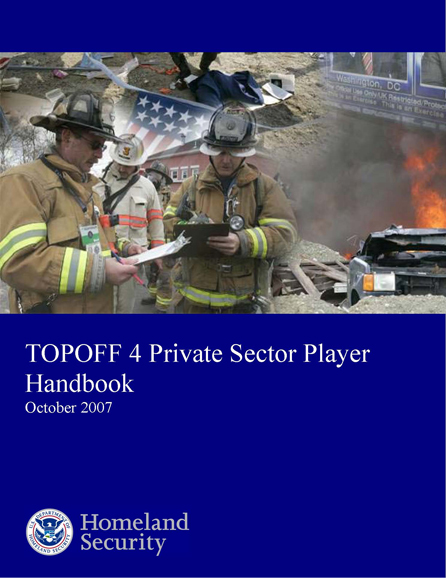TOPOFF 4 Full-Scale Exercise
- 37 pages
- For Official Use Only
- October 9 ,2007
4. The TOPOFF Exercise Series
The Top Officials (TOPOFF) exercise is a congressionally mandated national counterterrorism exercise series comprised of a cycle of building block activities designed to strengthen the nation’s capacities to prepare for, prevent, respond to, and recover from large-scale terrorist attacks. The T4 exercise series includes national seminars, a Full-Scale Exercise (FSE) that simulates multi-point terrorist attacks involving weapons of mass destruction (WMDs), and a Large-Scale Game (LSG) that focuses on medium- and longterm recovery and remediation issues resulting from the FSE. TOPOFF provides an excellent opportunity to exercise, train, and educate top officials from Federal, State, Tribal, Territory and local governments; international agencies’ and the private sector, including nongovernmental organizations. TOPOFF supports the Homeland Security Council and the National Security Council Policy Coordinating Committee on counterterrorism and National Preparedness Exercise Subgroup’s requirement for large-scale counterterrorism exercises. Public Law 106-553 authorizes the TOPOFF exercise series; concurrently, Senate Report 106-404 outlines its concept. The U.S. Department of Homeland Security, Federal Emergency Management Agency, National Preparedness Directorate, is responsible for designing and implementing TOPOFF.
5. The T4 FSE Exercise Concept/Scope
The T4 FSE is a 10-day exercise involving the states of Arizona and Oregon, the Territory of Guam, various federal departments and agencies, the countries of Australia, Canada, Mexico and the United Kingdom and the private sector to achieve their training and exercise objectives.
During the T4 exercise, Guam and the State of Oregon (Portland) will play a full-scale exercise; Arizona will play a Command Post Exercise.
The intelligence buildup will occur 60 days prior to the start of the exercise (STARTEX). Private sector players should assume five business days of activity following the first exercise “incident.” We expect private sector play will actively occur from October 16-18, 2007 during normal business hours.
…
11. Scenario Confidentiality
The exercise poses politically sensitive issues and may portray detailed response plans and potential response shortcomings. Planners and participants must treat exercise-related information as sensitive and FOR OFFICIAL USE ONLY
…
SYSTEMIC OBJECTIVES
1. Exercise procedures and protocols required for timely information flow between the Intelligence Community ( IC ) and relevant CI/KR owners and operators during the prevention, response, and recovery phases of a crisis/emergency including:
• Tactical intelligence warnings and alerts from the IC to affected CI/KR decision makers;
• Tactical information from CI/KR participants to affected state, territory, and national fusion centers ( including HITRAC ); and
• Use of the IT-ISAC and other sector ISAC’s as a two-way dissemination node for national-level intelligence and other tactical information
2. Test emergency/crisis communications capabilities (e.g. GETS, WPS, CWIN) recognizing and acknowledging the inevitable adverse impact on traditional communications capabilities in the event of an incident of national significance. This will be particularly significant for first responders, health care providers, incident command post, JFO, and others during the various phases of the response, recovery, and reconstitution efforts. Given historical lessons learned, it may be valuable to utilize time intervals in the development of the injects ( 1st four hours following detonation; 1st 12 hours; 1st 24 hours; etc )
3. Test alternative information sharing capabilities recognizing and acknowledging the inevitable adverse impact (loss of access, degradation of service, etc) to traditional access during an incident of national significance. This again will be particularly relevant to first responders, command post leadership, JFO, law enforcement, health care providers, and others during the various phases of the response, recovery, and reconstitution efforts.
4. Test Emergency Notification System (ENS).
5. Test the provisions of the NRP, NIMS, and respective ESF plans as it relates to actual declaration of an incident of national significance and determination of clarity and predictability regarding the triggering of the Stafford Act, Defense Production Act, et al, and what that actually means in terms of the availability of resources in the event of a crisis/emergency.
6. Test the issues of onsite access and security (credentialing, authentication, etc) for CI/KR professionals that may be necessary to evaluate damage, effect repairs, or stand up interim provisions during a crisis/emergency. Given the nature of this scenario, this objective will have both venue and national-level implications.
…
21. Private Sector Working Groups
The U.S. Department of Homeland (DHS), National Preparedness Directorate, Federal Emergency Management Agency Security’s integrated private sector participation in the T4 FSE, through Private Sector Working Groups (PSWG) at a national level and in each of the venues. Private sector planners included private sector companies, associations or organizations, at both the national level and in the three exercise venues. The role of these working groups was to help develop the T4 exercise to assure private sector objectives are defined and achieved and to assure active engagement of the private sector by serving as an intermediary between the private sector participants and the T4 exercise staff. Also, the working groups enabled government/private sector integration, as well as provided a working venue for identifying and addressing the impact of cascading and cross-sector effects of the scenario.

